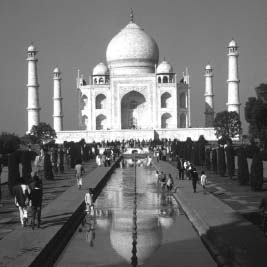IslamHistory and Sources |
How did Islam become important in South Asia? |
Further east than Iraq and Iran, the Mughal dynasty (1502-1757) established Islamic rule over much of South Asia, from Afghanistan across at least the northern two-thirds of India. Great monarchs such as Akbar, Jahangir, and Shah Jahan turned cities like Delhi and Agra into architectural showpieces with works like the Taj Mahal. After about the mid-eighteenth century, European colonialism began to make inroads into lands formerly under Islamic regimes. Not until the mid-twentieth century did major colonial powers begin to withdraw, ceding political control back to indigenous populations. One dramatic example of that relatively recent change is the independence of India from Britain and the partition of India that created the Muslim state of Pakistan (1948), itself divided in 1971 into Pakistan and Bangladesh.
| Year | Event |
| 570 | Birth of Muhammad |
| 595 | Muhammad’s marriage to Khadija, mother of Fatima |
| 610 | Initial revelation of Qur’an to Muhammad through the angel Gabriel |
| 622 | Hijra, emigration of Muslim community from Mecca to Medina |
| 632 | Muhammad’s death in Medina |
| 632-661 | Period of the “Rightly Guided Caliphs,” first successors to Muhammad |
| 661-750 | Period of the Umayyad Dynasty, capital at Damascus, major expansion as far as Spain and India; gradual development of Shi’a Islam following death of Ali |
| 750-1258 | Period of the Abbasid Dynasty, capital at Baghdad, gradual breakdown into regional political entities from Spain to India |
| 750-900 | Formation of the four major Sunni schools of religious law, major developments in Qur’anic exegetical sciences, canonization of the Hadith literature |
| 700-765 | Ja’far as-Sadiq, generally acclaimed as Sixth Imam by all Shi’a Muslims |
| 857-922 | Hallaj, acknowledged by Sufis as first martyr-mystic |
| 873-935 | Ash’ari, systematic theologian responsible for crucial religious studies synthesis |
| 980-1037 | Ibn Sina, a.k.a. Avicenna, major Central Asian philosopher (from Uzbekistan) |
| 1088-1166 | ‘Abd al-Qadir al-Jilani, early influence on institutionalization of Sufi communal life |
| 1099-1189 | First Crusade resulting in Latin Kingdom of Jerusalem, ended by Saladin |
| 1189-1290 | Muslim responses to subsequent major Crusades leave Muslims in control of most of the central Middle East |
| 1100-1400 | Growth and spread of major Sufi brotherhoods from Iberia to Indonesia |
| 1059-1111 | Abu Hamid al-Ghazali, influential religious thinker and author |
| 1126-1198 | Ibn Rushd (Averroes), famed Iberian-born philosopher (from Cordoba) |
| 1210-1526 | Delhi Sultanates, powerful Muslim presence in India |
| 1250-1517 | Mamluk dynasty in Egypt and central Middle East |
| 1258 | Mongols destroy Baghdad, ending the Abbasid Dynasty |
| 1207-1273 | Jalal ad-Din Rumi, major Sufi poet, originator of “Whirling Dervishes” (Sufi order known officially as the Mawlawiya) |
| 1300-1921 | Ottoman Dynasty rules Turkey and much of the eastern Mediterranean |
| 1263-1328 | Ibn Taymiya, major religious scholar of the Hanbali law school |
| 1453 | Fall of Byzantine capital at Constantinople to Ottoman Turks |
| 1492 | Fall of the Nasrid Dynasty in Granada, last major Muslim presence in Spain |
| 1414-1492 | Jami, major Sufi mystical poet |
| 1470-1506 | Behzad, influential miniature painter from Timurid Herat (Afghanistan) |
| 1526-1757 | Mughal Dynasty rules much of India |
| 1489-1578 | Sinan, chief architect of Sulayman the Magnificent, one of the Muslim world’s greatest designers of religious space |
| 1791 | Death of Muhammad ibn Abd al-Wahhab, founder of Wahhabi movement in Arabian Peninsula |
| 1849-1905 | Muhammad Abduh, proponent of reason as source of knowledge |
| 1865-1935 | Rashid Rida, founder of Egyptian Salafi movement calling for retrival of pristine days of the Prophet |
| 1922-1924 | Mustafa Kemal Ataturk secularizes Turkish state |
| 1906-1949 | Hasan al-Banna, whose Muslim Brotherhood (1929) gains strength with failure of liberal Muslim governments and proclamation of the State of Israel |
| 1909-1966 | Sayyid Qutb, influential theorist of Muslim Brotherhood movement |
| 1947 | Partition of India creates Muslim state of Pakistan (East and West) |
| 1971 | Separation of East Pakistan as the nation of Bangladesh |
| 1979 | Islamic Republic of Iran proclaimed after overthrow of second and last Pahlavi Shah |
| 2010 | Global Muslim population reaches 1.57 billion |

The Taj Mahal, a seventeenth century tomb constructed by Mughal Muslim ruler Shah Jahan as a burial place of his favorite wife. It is located in Agra in north-central India.
